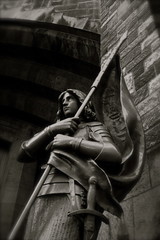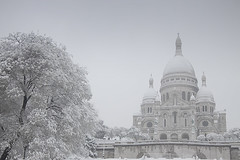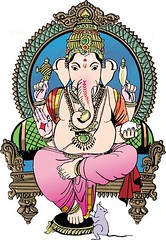This winter we are spending far more time in Paris than in Normandy. As most of you have heard by now, Europe has had the coldest, snowiest winter since the Ice Age. A 600 year-old, uninsulated house in the Basse Norman countryside won't cut it this year, not even for a little while. So, we're ensconced in our new little Paris flat in the 18eme until we see signs of spring.
We're in a lively part of the 18eme where the volume of a dozen different dialects is always up and the culinary wafts in the air are as much Southeast Asian spice merchant or North African cous-cous vendor, as they are French boulangere or fromager. While hectic and sometimes a bit trop aggressive, it is interesting and always tasty!
We're also in a zone I've coined the Sacred Triangle.
On one tip and across the tracks, is the Sacre Coeur. On another is the new Ganesha Temple. And on the third, closest to us, is La Basilique Ste Jeanne d’Arc/L’église St-Denys de la Chapelle. In between are several small, austere mosques, tucked into old Haussmann courtyards or behind cafes.
A sacred place, in its purest form, is where for centuries humans have flocked to connect to something larger than ourselves. We come looking for a connection to a community. Through ritual we offer our best intentions, request guidance, find a moment of peace, and give ourselves permission to safely let down the guard; to be vulnerable and humble. In these places we're allowed to quiet the noise so that for even just a moment, we can hear that tiny voice of truth that lies in the heart; that voice that reminds us to love well.
While the Sacre Coeur has a morally questionable history, it was constructed during an era when many of the French were clamoring for a spiritual renewal to help them heal from a long period of war and crippling poverty. It looms large and beckons far atop the butte Montmartre. Roman Catholics from all over the world climb those steps to make their pilgrimage. (As do millions of tourists looking for Amelie's gnome.) On one snowy morning in January 2003, at 6:30 am, on the way to the airport, this guy (while not remotely Catholic, just always inspired by an excellent view) paid a taxi driver to take us to the top, where he proposed as we gazed out over sparkly, snow-covered Paris!
The Ganesha Temple recently got an upgrade - from a crumbling Haussmann, to a shiny new storefront on rue de la Chappelle. The Temple honors this beloved Hindu diety; the half boy, half elephant son of Shiva, who fearlessly helps us moves the obstacles on our path to a more fulfilling and honorable life. Every August, this entire region of the 18eme, led by the Tamil Hindu community, participates in and celebrates the Ganesha Festival that I describe in more detail here.
Om gam ganapataye namaha!
La Basilique Ste Jeanne d’Arc/L’église St-Denys de la Chapelle, dating from 1204, is literally a few doors away from us. As the story goes, back when this region was still a tiny agricultural village and long before it had been annexed to Paris, Jeanne d'Arc retreated here after a bloody campaign in Paris. She was badly injured and in need of care and convalescence. The chapel and village offered a safe haven. Once she became canonized as a Patron Saint of France, this location gained in religious and spiritual importance. The interior of the chapel is full of prints, sculptures, and statues of Joan; the teenage girl who followed her inner voice - in a BIG way.
Despite its romance and beauty, Paris can be a pretty cold, lonely, and unforgiving place at times. As a yoga teacher and forever student, there's something auspicious, comforting, and humbling for me about landing in this sacred triangle amidst all of the raw, urban grit. Beyond the grime and density and noise, I feel layers of karmic insulation. I can only hope that through my conscious intentions and practice of abhyasa (always showing up to share my practice) and vairagya (non-attachment/unentitlement) my behavior, in just a small way, will only contribute to the sacredness of this place.
As I reflect on the heinous crimes recently committed in my country of origin, I'm reminded of a few fundamental things: one is never truly alone; suffering (dukha) and the ability to inflict it on others develops in mis-perceived isolation brought on by duality; and ultimately we are all seeking the same basic things.
"...We recognize our own mortality, and are reminded that in the fleeting time we have on this earth, what matters is not wealth, or status, or power, or fame - but rather, how well we have loved, and what small part we have played in bettering the lives of others." President Barack Obama, January 2011


